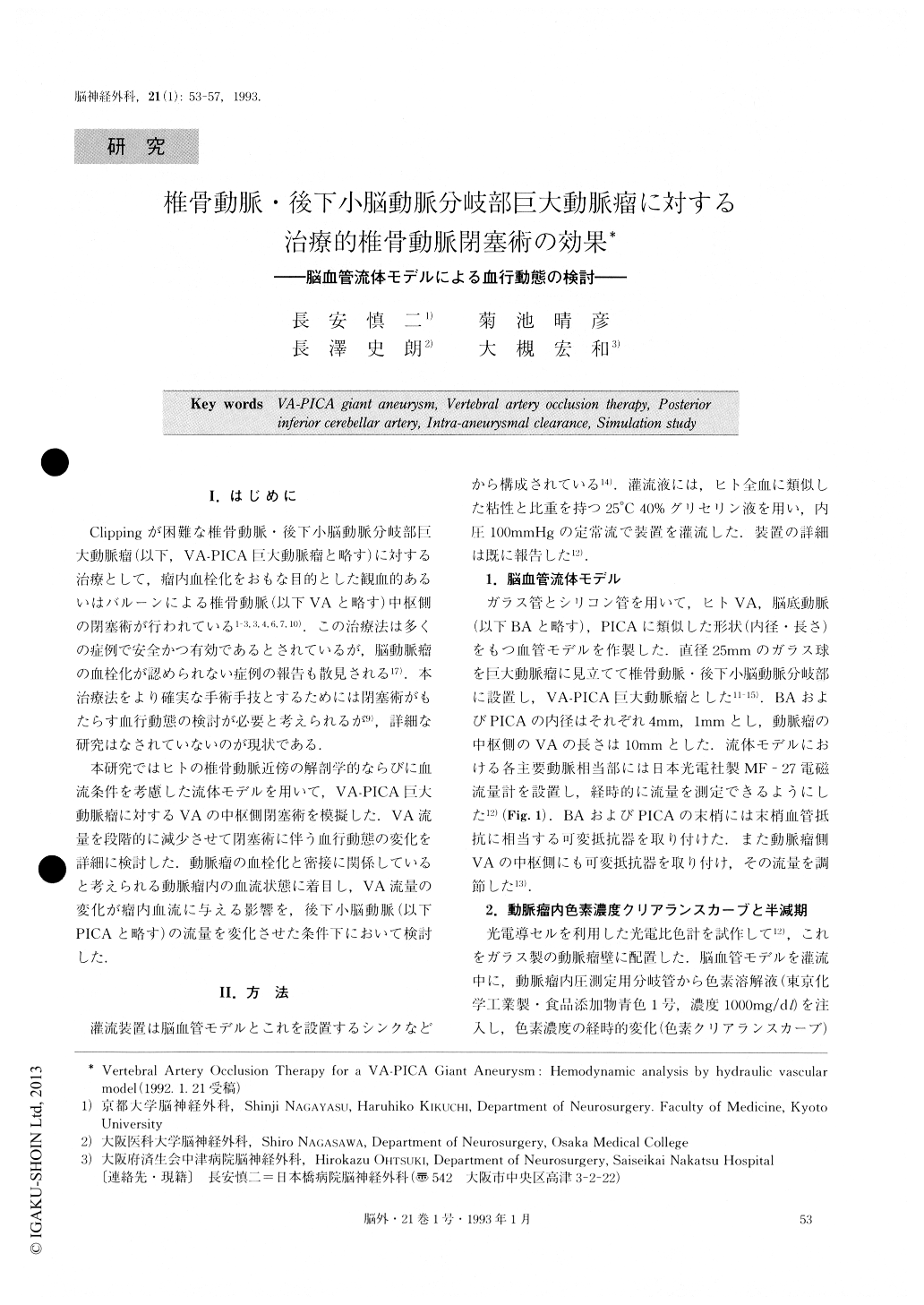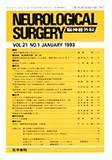Japanese
English
- 有料閲覧
- Abstract 文献概要
- 1ページ目 Look Inside
I.はじめに
Clippingが困難な椎骨動脈・後下小脳動脈分岐部巨大動脈瘤(以下,VA-PICA巨大動脈瘤と略す)に対する治療として,瘤内血栓化をおもな目的とした観血的あるいはバルーンによる椎骨動脈(以下VAと略す)中枢側の閉塞術が行われている1-3,3,4,6,7,10).この治療法は多くの症例で安全かつ有効であるとされているが,脳動脈瘤の血栓化が認められない症例の報告も散見される17).本治療法をより確実な手術手技とするためには閉塞術がもたらす血行動態の検討が必要と考えられるが9),詳細な研究はなされていないのが現状である.
本研究ではヒトの椎骨動脈近傍の解剖学的ならびに血流条件を考慮した流体モデルを用いて,VA-PICA巨大動脈瘤に対するVAの中枢側閉塞術を模擬した.VA流量を段階的に減少させて閉塞術に伴う血行動態の変化を詳細に検討した.動脈瘤の血栓化と密接に関係していると考えられる動脈瘤内の血流状態に着目し,VA流量の変化が瘤内血流に与える影響を,後下小脳動脈(以下PICAと略す)の流量を変化させた条件下において検討した.
Although therapeutic occlusion of the vertebral artery has been an accepted treatment for an inaccessible VAgiant aneurysm, several problems have been reported such as incomplete thrombosis, growth or rupture of the aneurysms, and cerebral embolism originating from the aneurysmal cavity. Hemodynamic changes after occlu-sion therapy are suspected to be responsible for these phenomena. It is usually difficult to solve these problems or to predict them before operation because multiple fac-tors are related in a complex fashion in a living body. One of the effective means is to simulate these hemody-namic conditions by a hydraulic vascular model. To evaluate hemodynamics after gradual therapeutic occlusion of the vertebral artery, a glass sphere of 2.5cm in diameter was placed in a hydraulic model and re-garded as a VA-PICA aneurysm. 40% glycerol solution at 25℃, having similar viscosity and specific gravity to human whole blood at 37℃, was used as a perfusate in this study. The dye was injected into the aneurysm and intensity change of the transmitted light was measured. Half-life of the dye was calculated from the thus-obtained clearance curve and was regarded as an index of intraaneurysmal stagnation. The flow volumes of each arterial site have been estimated in our previous study: 60ml/min to the territory of one posterior cere-bral artery, and 80ml/min to the cerebellum and the brain stem. Clearance curves were recorded in the follow-ing various conditions. The flow value of the PICA was set to be 5, 10, 15, 20, 25, and 30ml/min. In each flow value, flow through the VA of the aneurysmal site was changed from 120ml/min to 0ml/min, simulating gra-dual occlusion of the artery. The flow values of proximal VA to the aneurysm. PICA and distal VA are designed as F1, F2, and F3.
The results are as follows;
1) Half-life is determined by the tangential flow value to the aneurysmal neck (F3), independent of F, or F2 values.
2) The value of half-life is not changed to less than 25 seconds until the F3 value decreases from 120ml/min to 30ml/min.
3) It begins to increase gradually around the F3 value of 30m //min. and markedly thereafter. The dye is no longer cleared at the F3 value of 0ml/min, when the VA flow (F,) is equal to PICA flow (F2).
4) Reversed flow from the VA of the opposite side is observed when the VA is completely occluded (-F2= F.1). Under this condition, the value of half-life is less than 60 seconds in the range of the F, value more than 20ml/min.
For the thrombosis of the VA-PICA giant aneurysm, partial occlusion of the proximal VA is preferable, so as to have the residual flow value equal to that of PICA. This is especially recommended when the PICA flow is more than 20ml/min.
Although rigid application of this result to the clinical field may have some limitations, this simulation study is believed to be one of the effective means of evaluating the effect of therapeutic occlusion of the vertebral artery.

Copyright © 1993, Igaku-Shoin Ltd. All rights reserved.


